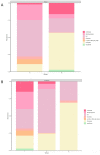Dose-Dependent Effects of Supplementing a Two-Strain Bacillus subtilis Probiotic on Growth Performance, Blood Parameters, Fecal Metabolites, and Microbiome in Nursery Pigs
- PMID: 38200840
- PMCID: PMC10777967
- DOI: 10.3390/ani14010109
Dose-Dependent Effects of Supplementing a Two-Strain Bacillus subtilis Probiotic on Growth Performance, Blood Parameters, Fecal Metabolites, and Microbiome in Nursery Pigs
Abstract
This experiment was conducted to evaluate the effects of dietary supplementation level of a two-strain Bacillus subtilis probiotic on growth performance, blood parameters, fecal metabolites, and microbiome in nursery pigs. A total of 54 weaned piglets were allotted to three treatments in three replicate pens with six pigs/pen for a 28 d feeding trial. The treatments were as follows: control: no probiotic supplementation; Pro1x: B. subtilis supplementation at 1.875 × 105 CFU/g diet; and Pro10x: B. subtilis supplementation at 1.875 × 106 CFU/g diet. Body weight at d 14 postweaning (p = 0.06) and average daily gain for d 0 to 14 postweaning (p < 0.05) were greater in the Pro1x treatment than in the other treatments. Blood glucose levels were greater in both probiotic treatments than in the control treatment at d 14 postweaning (p < 0.05). In the fecal short-chain fatty acid (SCFA) concentrations, the butyrate concentrations were greater in the Pro1x treatment than in the other treatments (p < 0.05), and the acetate, propionate, and total SCFA concentrations were greater in the Pro1x treatment than in the Pro10x treatment (p < 0.05). The beta diversity of fecal microbiome composition at d 14 postweaning based on Unweighted Unifrac analysis was dissimilar between the Pro1x and Pro10x treatments (p < 0.05). In conclusion, dietary B. subtilis supplementation of two strains selected to reduce effects of pathogenic Escherichia coli to nursery diets at 1.875 × 105 CFU/g diet improved the growth rate in the early postweaning period, increased fecal SCFA concentrations and altered the fecal microbial community composition. A higher dose of B. subtilis did not improve the performance parameters over those of the control piglets.
Keywords: Bacillus subtilis; growth; pigs; short-chain fatty acids; supplementation level; weaning.
Conflict of interest statement
The authors declare no conflict of interest except that A.H.S., S.H. and S.J.W. are employees of Arm & Hammer Animal and Food Production.
Figures



Similar articles
-
Effects of Bacillus subtilis C-3102 on sow and progeny performance, fecal consistency, and fecal microbes during gestation, lactation, and nursery periods1,2.J Anim Sci. 2019 Sep 3;97(9):3920-3937. doi: 10.1093/jas/skz236. J Anim Sci. 2019. PMID: 31292631 Free PMC article.
-
Potential effect of two Bacillus probiotic strains on performance and fecal microbiota of breeding sows and their piglets.J Anim Sci. 2022 Jun 1;100(6):skac163. doi: 10.1093/jas/skac163. J Anim Sci. 2022. PMID: 35512239 Free PMC article.
-
Effects of Bacillus subtilis DSM32315 supplementation and dietary crude protein level on performance, gut barrier function and microbiota profile in weaned piglets1.J Anim Sci. 2019 Apr 29;97(5):2125-2138. doi: 10.1093/jas/skz090. J Anim Sci. 2019. PMID: 30883644 Free PMC article.
-
Bacillus subtilis: a potential growth promoter in weaned pigs in comparison to carbadox.J Anim Sci. 2020 Sep 1;98(9):skaa290. doi: 10.1093/jas/skaa290. J Anim Sci. 2020. PMID: 32877510 Free PMC article.
-
Influence of yeast-based pre- and probiotics in lactation and nursery diets on nursery pig performance and antimicrobial resistance of fecal Escherichia coli.J Anim Sci. 2022 Jun 1;100(6):skac166. doi: 10.1093/jas/skac166. J Anim Sci. 2022. PMID: 35524733 Free PMC article.
Cited by
-
Bacillus siamensis Improves the Immune Status and Intestinal Health of Weaned Piglets by Improving Their Intestinal Microbiota.Microorganisms. 2024 May 17;12(5):1012. doi: 10.3390/microorganisms12051012. Microorganisms. 2024. PMID: 38792841 Free PMC article.
-
Bacillus spp. as potential probiotics: promoting piglet growth by improving intestinal health.Front Vet Sci. 2024 Jul 26;11:1429233. doi: 10.3389/fvets.2024.1429233. eCollection 2024. Front Vet Sci. 2024. PMID: 39132437 Free PMC article. Review.
References
-
- Vieira A.M., Sessin A.P., Soratto T.A.T., Pires P.G.D.S., Cardinal K.M., Wagner G., Hauptli L., Lima A.L.F., Dahlke F., Netto D.P., et al. Effect of functional oils or probiotics on performance and microbiota profile of newly weaned piglets. Sci. Rep. 2021;11:19457. doi: 10.1038/s41598-021-98549-w. - DOI - PMC - PubMed
-
- Jang Y.D., Oh H.K., Piao L.G., Choi H.B., Yun J.H., Kim Y.Y. Evaluation of probiotics as an alternative to antibiotic on growth performance, nutrient digestibility, occurrence of diarrhea and immune response in weaning pigs. J. Anim. Sci. Technol. 2009;51:25–32. doi: 10.5187/JAST.2009.51.1.025. - DOI
Grants and funding
LinkOut - more resources
Full Text Sources

